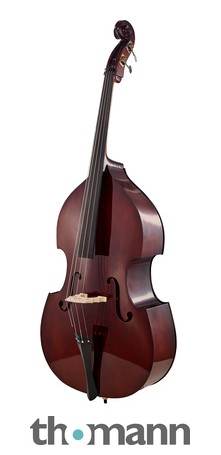The Differences Between Cello and Double Bass

Cello and double bass are both string instruments from the Violin family. However, the double bass is significantly larger. Compared to cello, a double bass has a much deeper sound with the latter being tuned in the 4ths. A Cello is tuned in perfect 5ths and has a more melodic, richer sound.
When two instruments belong to the same family and share a similar look, it can be difficult to tell them apart. Especially if you are not familiar with instruments.
However, in the case of the cello and the double bass, it’s fairly easy to know which one is which. And that’s what we will do today. We will get deep into the differences and similarities between the two so that when the next time you hear them or want to purchase one, you would not have any problem.
Contents
What is a Cello?
Cello is a bowed string instrument from the Violin family. Earlier versions of the Cello were first introduced in 16th century Italy, in opera and orchestral settings. A cello player is called a cellist and plays the instrument either solo or with a band/orchestra.
The cellist sits on a throne while the cello is placed upright between the player’s legs. The most common playing method of a cello is using a bow, made of wood and horsehair. Although, in many cases, the instrument is also plucked.
Compared to a violin or a viola, it has a deeper sound with its 4 strings tuned in perfect fifths, C2, G2, D3, and A3. Because of its rich sound, it is used in both melodic and rhythmic sections.
If you are interested in buying a cello, a good recommendation would be the Cecilio CCO-500. It is an excellent beginner instrument while also lasting you up until intermediate or even advanced level.
Cecilio is a top cello maker and the CCO-500 is a good example of that. The cello is made of solid wood and shows great craftsmanship. It also sounds really good while being easy to play. You also get everything you need to get started, including a bow, stand, case, rosin, bridge, and extra strings.
What is a Double Bass?
The double bass is the biggest member of the Violin family. Up until the 20th century, there used to be three strings on it. Today, it has four strings tuned in fourths. It is the only contemporary bowed string instrument to have this tuning.
Some people call it the stand-up/upright bass, some call it the acoustic bass, while others simply call it the double bass. The point is that the instrument is known by many names, so don’t get confused if you hear a different one.
The strings are generally tuned in E1, A1, D2, and G2. Since double bass is a pretty big instrument, it is predominantly used in the rhythm section. It has found a home in many genres, ranging from orchestral to jazz to funk and reggae.
A double bass player is called a bassist. Just like the cello, a double bass can be played with a bow or plucked by hands. Although with the latter, there are a lot of extended techniques.
If the double bass has piqued your interest, you can get started with the Thomann 111BR 3/4 Double Bass. It’s relatively inexpensive for a double bass while having a nice, natural sound.
The 111BB is ¾ the size of a true double bass. It is very well made with solid German craftsmanship behind it. In addition to being easy and fun to play, it also comes with a gig bag and a bow.
Differences between Cello and Double Bass
Now that you’re familiar with what a cello and double bass are, let’s take a look at what separates them. And despite being from the same family, there are quite some differences between the two.
First off, the size. A cello is noticeably smaller than a double bass. The biggest cello is about five and a half feet while the biggest bass can tower around seven feet.
There is a huge difference in the sounds between the two. While a cello has a deeper tone than a violin, it still sits on the melodic side. It sounds rich and resonant. The sound of a double bass is much deeper than that of a cello. In fact, it can match the lowest notes of a piano. Thus it’s considered a rhythmic instrument.
The string on a cello is tuned in perfect fifths going C2, G2, D3, and A3. It is considered quite versatile since it has a tonal range of five octaves.
A double bass, on the other hand, has a tonal range of four octaves. It is tuned in fourths going E1, A1, D2, and G2, unlike other bowed string instruments.
As there is a big difference in the size, the cello and bass have to be played differently. A cellist sits down and places the instrument between the legs while a bassist has to stand up to play the double bass.
Both cello and double bass are considered pretty expensive instruments. However, if we take similar wood and the same manufacturer, a double bass would cost much more. This is mostly because a double bass uses more material.
In which setting are they usually played?
Cello and double bass have their origins in the orchestra. But as time changed, so did their applications.
A cello is most commonly played in orchestral and classical music. Both western and eastern. It is also played a lot in jazz and some folk music.
A double bass, however, has a lot more applications. While it is also used in orchestral and classical music, it has found a place in jazz as well. You can also find amplified double bass parts in reggae, funk, and blues.
Summary
Cello and double bass are, both, members of the bowed string family and are cousins with the violin. They share a lot of similarities like their looks, material, origins, and playing style. However, there are also a lot of differences like their size, sound, and tuning.
By now, I’m sure you have a much better understanding of the two. So, the next time you hear these instruments, you will easily be able to tell them apart.







